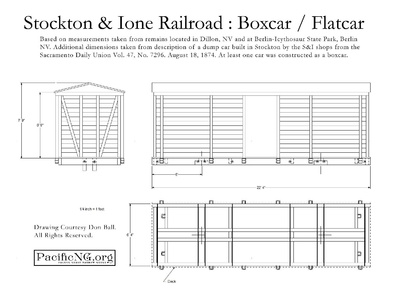Stockton & Ione Railroad Equipment Roster
California / Common Carrier / Stockton & Ione Railroad / Stockton & Ione Railroad Equipment Roster
Locomotives
| Name | Whyte | Builder | Date | CN | Notes | |
|---|---|---|---|---|---|---|
| Stockton | 0-4-4T | Mason | 1875 | 551 | Mason-Bogie, c/n 564, March 1875, 12x18, 40” drivers, 39,000 lb. Built new for Stockton & Ione Railroad. Arrived in Stockton on XXX aboard the ship XXXX. Sold, October 1876 to James M. Coleman for Seattle & Walla Walla Railroad. Arrived in Seattle XXXXX, renamed A. A. Denny Rebuilt to 0-6-4T by S&WW shops in 1878 on account of being “top heavy”. Out of service by 1897. Scrapped | |
| Amador | 0-6-4T | Mason | 1875 | 552 | Mason-Bogie. Built new for Stockton & Ione Railroad. Arrived in Stockton on XXXX aboard the ship XXXX. Returned to Mason Machine Works. Sold to Covington, Columbus & Black Hills RR as #2 Dixon. May have been repainted as the Taunton for resale as a catalog engine. |
Freight Equipment
Remains of former Stock & Ione cars along the former Nevada Central Railroad grade were recorded in two different lengths. Two surviving car bodies at Bobtown and Watts were measured 20 ft long and believed to be original flat cars. A car remaining at Dillon was 22 ft long which may have been a box car or a NC built box car built using a S&I dump car frame.
3 Box cars
Drawings.
2 Flat cars.
Dump Cars. Wheels built by Risdon Iron Works. Trucks built locally.
A New Style or Dump Car. — Holt, the carbuilder for the Stockton and lone NarrowGauge Railroad Company, has finished a flat car of a new pattern. It is constructed in such a manner as to enable one man to dump the load in less than a minute. The body of the car rests on two ball-and-socket joints, one joint in the center of each truck, and through each joint passes a heavy king-bolt, the head of which rests loosely in the hollow cup of the ball or upper part of the joint. The body of the car likewise rests on a chafe-block on each outer side of the truck frame, and by moving the two blocks on the same side of tbe car, the platform bed is dumped over to the opposite side. These blocks bold the bed level and secure, and by moving two of them the load can be thrown off in an incredibly short time. Each block is fastened or unfastened by moving a lever about a foot in length. These levers are held in place by swinging crotches or hasps fastened to the underside of the platform outer sill. The length of the car is twenty-two feet, and six feet four inches wide. The weight is two tons and a half, and it is calculated that it will, with safety, carry even seven tons and a half. The car has two trucks of four wheels each. The wheels are twenty-four inches in diameter, and were cast at the Risdon Iron Works, San Francisco, and all the other castings were produced in this city. Miller, the Superintendent, has made the necessary drawings for passenger coaches, which are to be built by Hoit in the company's shop.—[Stockton Independent, August 17th. Sacramento Daily Union. August 18, 1874
Passenger Equipment
1 - Combination Car.
1 - Passenger Car (Incomplete).
Sources.
1875 California State Railroad Report.
Nevada Central Railroad Director's Report for December 5, 1879.
Information collected by Dave Eggleston.
California / Common Carrier / Stockton & Ione Railroad / Stockton & Ione Railroad Equipment Roster




